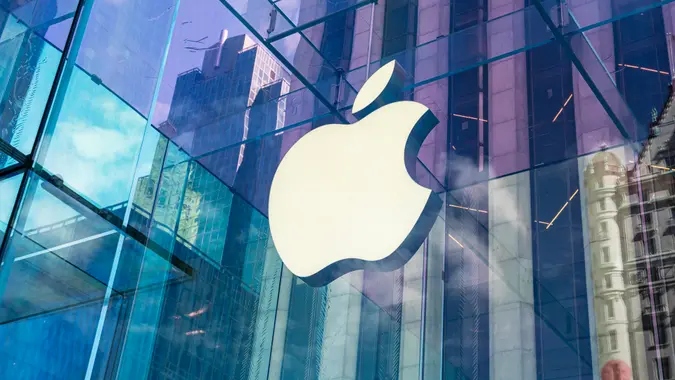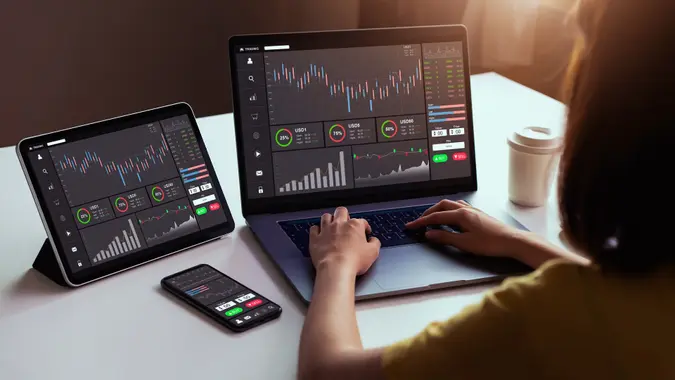How Does the Stock Market Work? A Simple Guide for Beginners

Commitment to Our Readers
GOBankingRates' editorial team is committed to bringing you unbiased reviews and information. We use data-driven methodologies to evaluate financial products and services - our reviews and ratings are not influenced by advertisers. You can read more about our editorial guidelines and our products and services review methodology.

20 Years
Helping You Live Richer

Reviewed
by Experts

Trusted by
Millions of Readers
Introduction to the Stock Market
The stock market works by providing a marketplace for the general public — as well as governments, businesses and fund managers — to buy and sell shares of publicly traded companies.
When you purchase a company’s stock, you become an equity shareholder — a partial owner — and create the opportunity to grow your wealth, not by exchanging your labor for income but by risking your savings on a business’s fortunes.
When you buy a company’s stock, you give it capital to hire workers, buy equipment, invest in technology and grow its operations. If the company turns a profit, you and all the other shareholders profit as the stock appreciates and — in some cases — issues dividends.
However, as the potential for gains increases, so, too, does the risk of loss. If the company loses money or fails — as some do — you could watch some or even all of the money you invested disappear.
What Is the Stock Market?
There is no one stock market where investors go to buy shares from companies. The term refers to a network of independent stock exchanges where licensed brokers buy, sell, and trade shares on behalf of investors.
Some, like the famous New York Stock Exchange (NYSE) on Wall Street in New York City, have physical locations. Others, like the National Association of Securities Dealers Automatic Quotations (NASDAQ), are completely electronic.
Either way, they function like auction houses, where brokers facilitate transactions between buyers and sellers — and they’re not unique to the United States. Countries and regions maintain their own, like Japan’s Tokyo Stock Exchange, for example.
Indices Are Different Than Exchanges
Don’t confuse stock exchanges with stock market indices like the Dow Jones Industrial Average and Nasdaq Composite. They are numerical representations that reflect the performance of baskets of related stocks. The S&P 500, which represents the 500 largest publicly traded U.S. companies, is the benchmark index for the market as a whole.
How Stocks Are Bought and Sold
Investors place different types of orders to instruct their brokerage on how to execute their transactions.
- Market orders: The most common type of order, market orders are often the default trade setting unless otherwise specified. It instructs the broker to execute a trade immediately at the best available price.
- Limit orders: Investors place limit orders when they’re more concerned with the price of a security than the speed of the transaction. Brokerages execute buy limit orders only when a stock falls to or below the order’s limit price. They complete sell limit orders only at or above the predetermined limit price.
- Stop orders: A stop order executes at market price once a stock reaches or passes through a certain price level. That makes it similar to a limit order but prioritizes making the trade even if it’s not at a specific, controlled price.
Why Companies Sell Shares
If stocks can build fortunes, why would the companies that issue them sell them in the first place? Because selling shares is the whole point of going public.
Privately held companies enjoy a level of privacy and control that they forfeit upon selling ownership shares to the general public. Also, taking a company public is a long, complex and expensive process that requires compliance with the rigid listing standards of the stock exchanges and compliance with strict and intrusive federal oversight through the Securities and Exchange Commission (SEC).
However, the SEC explains why the tradeoff can be well worth the effort.
- Publicly traded companies can quickly raise vast sums of capital without soliciting private investors.
- Public companies can use their stock to acquire other companies.
- Going public increases liquidity, which makes shares easier to sell.
- Public companies can attract top talent by including company stock and stock options in their benefits packages.
Going Public Means Making It to the Big Leagues
Going public can put companies on the map by drumming up publicity, building brand awareness, creating an air of prestige and credibility — and, most importantly, raising enormous sums of money.
- May 9, 2019: Uber raises $8.1 billion in a highly anticipated IPO that signals the start of the company’s tumultuous, controversial and disruptive rise to superstardom.
- May 17, 2012: Facebook becomes a household name and raises more than $16 billion in what remains the biggest U.S. tech IPO in history.
- March 18, 2008: The only U.S. company to top Facebook in any sector is Visa, which raised $17.86 billion in what is still the richest IPO in the country’s history.
What Drives Stock Prices?
Uber’s initial IPO success quickly devolved into a massive selloff and staggering losses.
Many factors contributed to the rout, and those who sold at the top got rich and those who engaged in late-stage panic-selling got drenched.
It was hardly an outlier.
Volatility — sometimes extreme volatility — is part of the game, and stock prices can rise and fall quickly and dramatically with little or no warning because of factors like:
- Supply and demand: COVID-era supply-chain woes illuminated the most basic concept of economics — when something is in high demand and short supply, buyers will pay more for it.
- Company performance and management: Earnings reports, product launches, leadership shakeups, scandals, mergers and acquisitions can send share prices up or down.
- External factors: Elections, wars, terrorist attacks, pandemics, changes in gas prices and other seemingly unrelated external events can impact stock prices.
Key Players in the Stock Market
Generally, investors fall into one of two classes:
- Retail: Retail investors are individuals who trade stocks for themselves in private portfolios they maintain with their personal funds.
- Institutional: Institutional investors are entities that trade stocks frequently and in large quantities on behalf of third-party people and organizations. They include, but aren’t limited to, pension funds, mutual funds, hedge funds, commercial banks, investment advisors, trusts and insurance companies.
Market makers are another key group of stock market participants. They compete to fulfill orders from time-crunched brokers throughout the trading day. These essential players provide liquidity and ensure seamless transactions by quoting both buy and sell prices of tradeable securities.
Risks and Rewards of Investing in the Stock Market
Investors trade stocks for their wealth-building potential.
- Stocks can appreciate or gain value over time, allowing long-term investors to buy shares now and sell them for a profit down the line.
- Many companies pay dividends — periodic cash distributions that shareholders can reinvest or use as income.
- More aggressive traders try to capitalize on market volatility by trying to time the market for short-term profit, a risky proposition with the potential for both big gains and devastating losses.
- Investors can leverage the value of their holdings without selling them by borrowing against them or using them as collateral.
Investors must take risks in pursuit of rewards. Here are the downsides to stock market investing.
- Unlike money in a savings account, stock investments are not insured or guaranteed.
- You can lose some or all of the money you invest.
- Market volatility can make it challenging to plan and prepare for financial needs and milestones like retirement or buying a home.
Risk-Mitigation Strategies
No matter your stock-investing strategy, reducing risk and increasing reward potential is the name of the game. The surest way to increase your odds of success is to invest first in professional guidance to turn your goals into viable strategies.
Most professionals make two key recommendations.
- Long-term investing: Very few people succeed in timing the market with frequent trades in pursuit of fast profits instead of buying high-quality, well-vetted stocks and funds and holding them for the long term.
- Diversification: The old adage of not putting all your eggs in the same basket holds true for the stock market. Betting big on one company can lead to disaster if that company turns out to be a “sure thing” like investors once believed Enron and Sears to be. Consider hedging your bets by spreading your money around — a single ETF can buy you an ownership stake in dozens, hundreds or even thousands of companies.
Brokerages and Apps
You must set up a brokerage account to trade stocks. Beginners often choose apps like Acorns, Robinhood, Stash and Public, which are user-friendly, simple and inexpensive. DIYers should use free, no-fee brokerages, while those seeking expert guidance or management might consider a full-service brokerage like Charles Schwaab or Fidelity, or at least a roboadvisor, which many of those same platforms offer.
How to Get Started in the Stock Market
In the not-too-distant past, stock investing was inaccessible to the masses because it required the services of brokers who charged steep fees and commissions. However, technology has democratized investing, and today, free online brokerages offer fractional-share and even round-up trading, enabling just about anyone on any budget to put their money in play.
Here’s how.
- Step 1: Open a brokerage account.
- Step 2: Set short-term and long-term investment goals.
- Step 3: Learn the basics of diversification.
- Step 4: Start with small investments and gradually build.
Conclusion
The stock market is a primary economic driver — its performance is a key indicator of the health of the overall economy. The market gives the general public the ability to purchase equity ownership shares in companies that they could never build on their own. They have the potential to make a lot of money over time — but the risk of loss is ever-present.
If you’re considering investing in stocks, start small while learning as much as you can, diversify your holdings, invest for the long term and schedule a session with an investment advisor before you get started.
Our in-house research team and on-site financial experts work together to create content that’s accurate, impartial, and up to date. We fact-check every single statistic, quote and fact using trusted primary resources to make sure the information we provide is correct. You can learn more about GOBankingRates’ processes and standards in our editorial policy.
- Charles Schwab. 2022. "Short Selling: The Risks and Rewards"
- Charles Schwab. "OTC (Over-the-Counter) Markets and Securities"
- Fidelity. "The guide to diversification."
- Financial Industry Regulatory Authority. 2022. "The Pros and Cons of Dollar-Cost Averaging."
- Charles Schwab. 2023. "3 Order Types: Market, Limit and Stop Orders."
- SoFi. 2023. "Actively Managed Funds vs Index Funds: Differences and Similarities."
- Investor.gov. "Types of Brokerage Accounts."
- Investor.gov. "Market Participants."
 Written by
Written by  Edited by
Edited by 
























